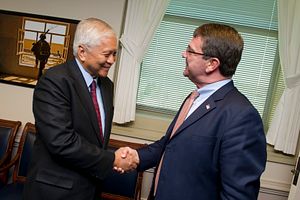U.S. Defense Secretary Ash Carter will visit India and the Philippines starting tomorrow to boost two of the United States’ critical relationships in the region.
Carter told reporters on board a Boeing 737 flight from New York to Washington, D.C., that his visit to the region – his first in 2016 – will seek to solidify gains that the Obama administration has made between a key emerging partner and a longtime ally as part of its rebalance to the Asia-Pacific.
India
In India, Carter will visit Goa at the invitation of his counterpart Manohar Parrikar as well as New Delhi where he will meet Prime Minister Narendra Modi and National Security Advisor Ajit Doval.
Both sides, Carter said, will take important steps to advance agreements agreed to in the previous year, principally the Joint Strategic Vision Statement signed between U.S. President Barack Obama and Indian Prime Minister Narendra Modi, as well as the 2015 Framework for the U.S.-India Defense Partnership which he inked with Parrikar in New Delhi, which will guide relations for the next decade (See: “What’s Next for US-India Defense Ties With Obama’s Trip?”).
“It’s to take some very important new steps that implement what the president and the prime minister agreed last year and the framework I signed with Minister Parrikar,” he said.
These steps, he said, related to various areas including joint military exercises, maritime security, and defense trade and technology through the Defense Trade and Technology Initiative (DTTI), an initiative that Carter championed during his time as deputy secretary of defense.
On maritime security, Carter told reporters that he would visit an Indian naval facility. There will also coincidentally be a U.S. naval vessel in port during his visit, which he said was another symbol of cooperation in this realm.
“We’ll have an opportunity in a very tangible and significant way to signify our cooperation in the area of maritime security,” he said.
Earlier, Carter told an audience in New York ahead of his trip that the India leg of the visit would include discussions about progress on various items including aircraft carrier, jet fighter, and jet engine collaboration (See: “US, India Conclude Aircraft Carrier Talks in New Delhi”). He also hinted that progress would be made in other domains as well.
“[W]e will talk about exciting new projects, the details of which I cannot go into this afternoon,” he said in an address to the Council on Foreign Relations, a think tank based in New York City.
He also said that U.S. defense officials and industry leaders were already in India looking at the potential co-production of fighter aircraft. Though Carter admitted that negotiations in some areas “can be difficult,” he said he had no doubt that a co-production agreement could be reached in the coming years.
“[I] have no doubt that in the coming years, the United States and India will embark on a landmark co-production agreement that will bring our two countries closer together and make our militaries stronger,” he said.
Philippines
In the Philippines, a longtime U.S. ally, Carter’s visit will center around recent progress made in the bilateral relationship on two items – the Enhanced Defense Cooperation Agreement (EDCA) as well as the Southeast Asia Maritime Security Initiative (MSI) (See: “Why the Philippines is Critical to the US Rebalance to Asia”).
The Philippines is a key country within MSI, a new initiative Carter announced last year which seeks to build the regional capacity of Southeast Asian countries to address a range of maritime challenges, ranging from typhoons to tensions in Asia’s waters (See: “America’s New Maritime Security Initiative for Southeast Asia”). With 80 percent of MSI’s budget this year going to Manila, Carter said this was an example of how Washington was “seizing new opportunities” in working toward boosting allied and partner capabilities in the maritime security domain.
“[O]ur having the initiative and the funding that goes with it that makes it possible, particularly for a country like the Philippines… it’s a very positive thing,” Carter told reporters.
Most of the funding to the Philippines this year will go towards enhancing the Philippines National Coast Watch Center, as well as other capabilities, including better sensors for Philippine navy patrol vessels and an aerostat reconnaissance platform.
Moreover, with the recent approval of the first five initial facilities under EDCA – a new defense pact inked by the two sides which, among others things, gives U.S. troops and equipment wide access to Philippine military bases on a rotational basis – Washington and Manila are set to further their defense cooperation (See: “A Big Deal? US, Philippines Agree First Bases Under New Defense Pact”). Carter will be visiting two of those five sites: Fort Magsaysay and Bautista Air Base.
“One of the big focus [areas] of the Philippines visit will be on the implementation of EDCA,” a senior defense official told The Diplomat.
Carter will also become the first U.S. defense secretary to observe the ongoing Balikatan exercises, originally a bilateral U.S.-Philippine military exercise that has grown to involve Australia. This year’s iteration will also include a number of additional observers (See: “US, Philippines Launch Wargames as China Issues Warning”).































